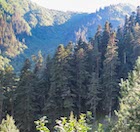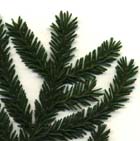
A tree about 15 m tall in the Washington Park Arboretum, Seattle, Washington [C. J. Earle, 2004.04.03].

A stand of mature trees in habitat near Teberda, Russia; iNaturalist observation 30868645 [mallaliev, 2014.08.15]

Mature seed cones on a tree in the Washington Park Arboretum, Seattle, Washington [C. J. Earle, 2004.04.03].

Pollen cones nearing maturity, and detail of needles and a twig on a tree in the Washington Park Arboretum, Seattle, Washington [C. J. Earle, 2004.04.03].

Foliage from an ornamental tree [C.J. Earle, 1999.03].

Picea orientalis
(Linnaeus) Peterm. 1838
Common names
Oriental spruce, Caucasian spruce (Farjon 1990); Ель восточная [Russian], Doğu ladini [Turkish].
Taxonomic notes
Syn: Pinus orientalis Linnaeus 1763. Type: Turkey: Trabzon, B, Balansa s.n. (neotype K, designated by Farjon in Jarvis [2007: 745).
Description
Trees to 60 m tall and 230 cm dbh, typically with a single straight round trunk and a dense, pyramidal to conical crown. Bark on larger stems rough and scaly, breaking into small plates, brown or gray-brown. Twigs short, slender, flexible, yellowish or pale brown, aging gray, short pubescent with narrow ridges and grooves; pulvini small. Vegetative buds ovoid-conical; terminal buds acute, 3-5 mm long, not resinous; bud scales appressed, but apices more or less free, reddish brown, persisting several years. Leaves dark glossy green above with whitish stomatai bands below; spreading radially, but pressed against shoot above, parted and nearly pectinate below, directed slightly forward, 6-8 × 0.7-1 mm (among the shortest in Picea), straight, transversely rhombic in cross-section, apex obtuse to acute; 1-2 lines of stomata on each dorsal face, 2-5 lines on each ventral face. Pollen cones axillary, 1-2 cm long, yellow. Seed cones terminal, erect, becoming pendulous at maturity, often very numerous, sessile, narrowly cylindrical, tapering towards apex, 4.5-10 × 2-3.3 cm when open; green, then purplish green or purple, ripening to red-brown or dark purplish brown. Seed scales broad-obovate or suborbicular, thin but stiff, slightly convex, 12-17 × 10-14 mm at mid-cone; finely striate, shining, undulate or flat, sometimes resinous, glabrous; upper margin rounded, entire or lacerate. Bracts small, included. Seeds ovoid, pointed at apex, 3-4 × 2-2.5 mm, red-brown or dark brown; seed wings 6-8 mm long, orange- or yellow-brown (Farjon 2010). See García Esteban et al. (2004) for a detailed characterization of the wood anatomy.
Distribution and Ecology
Georgia, Russia (Karachay-Cherkessia Republic), and Turkey, at elevations of (400-)700-2100 m in the mountains around the eastern end of the Black Sea. In Turkey found mainly on northern (seaward) aspects. Soils generally acidec; climate with cool to cold winters and warm, dry summers, with 1000-2000 mm annual precipitation. P. orientalis forms pure stands, especially at higher elevations, or mixed with codominant Abies nordmanniana. At lower elevations it occurs as scattered individuals in broad-leaved forests with Fagus orientalis, Acer spp., Ilex colchica, and some Taxus baccata (Farjon 2010).
Hardy to Zone 5 (cold hardiness limit between -28.8°C and -23.3°C) (Bannister and Neuner 2001).
Remarkable Specimens
There is an old record of a tree 57 m tall and 400 cm dbh near Teberda, Russia (Vladimir Dinets e-mail 1998.01.02). That is really not a plausible dbh; more likely it is a girth measurement, and an approximate one at that.
The oldest known living specimen, 302 years, was documented in a tree-ring chronology covering the period 1686-1989 (crossdated after 1708), collected near Gumushane, Torul Isletmesi, Turkey by Peter Kuniholm (doi.org/10.25921/zve8-s253). There is only one recorded collection of this species, and considerably older trees may exist.
Ethnobotany
This is an important commercial timber species in the Caucasus, and has been introduced for use in plantation forestry elsewhere in eastern Europe (Farjon 2010).
Observations
Remarks
The epithet means "eastern," and so it is, from Linnaeus' point of view.
Citations
Farjon, Aljos. 1990. Pinaceae: drawings and descriptions of the genera Abies, Cedrus, Pseudolarix, Keteleeria, Nothotsuga, Tsuga, Cathaya, Pseudotsuga, Larix and Picea. Königstein: Koeltz Scientific Books.
Jarvis 2007 cited in Farjon 2010.
Petermann, Wilhelm. 1838-45. Das Pflanzenreich. Leipzig: Eisenach. P. 235.
See also
Elwes and Henry 1906-1913 at the Biodiversity Heritage Library. This series of volumes, privately printed, provides some of the most engaging descriptions of conifers ever published. Although they only treat species cultivated in the U.K. and Ireland, and the taxonomy is a bit dated, still these accounts are thorough, treating such topics as species description, range, varieties, exceptionally old or tall specimens, remarkable trees, and cultivation. Despite being over a century old, they are generally accurate, and are illustrated with some remarkable photographs and lithographs.





